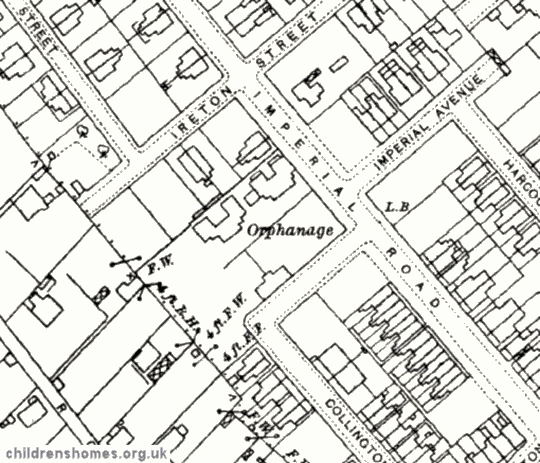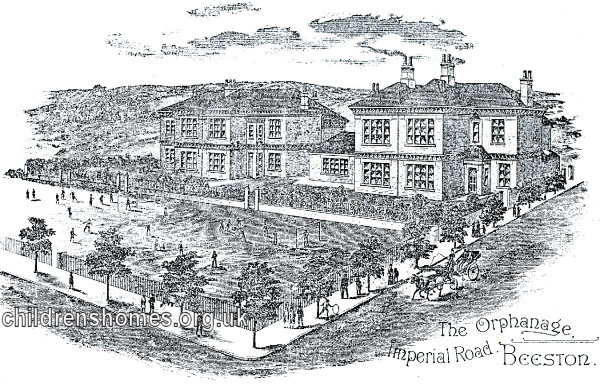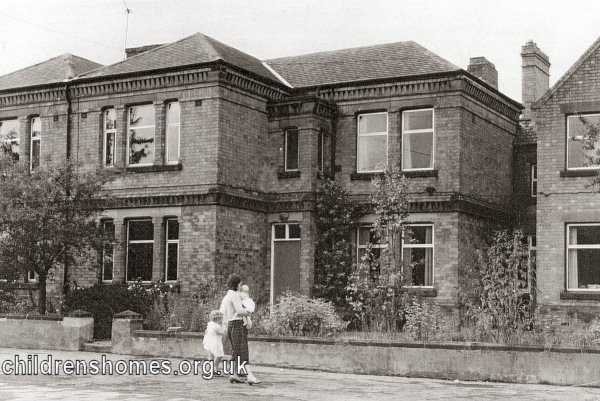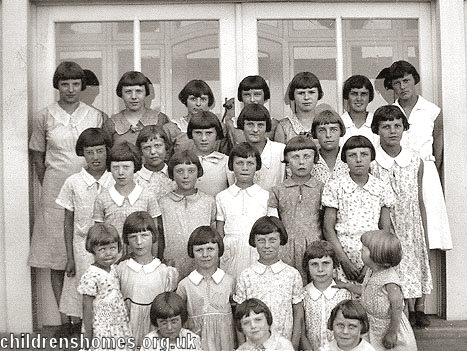Day Nursery and Orphanage, Nottingham / Beeston, Nottinghamshire
The Day Nursery and Orphanage was established in 1875 by Katherine Bayley, of Lenton Abbey. It originally occupied premises at 2 High Pavement, Nottingham. Here is Katherine Bayley's own account (slightly abridged) of the founding of the Orphanage and its first two years of operation:
The institution subsequently divided its operation between two locations. The Day Nursery occupied premises at 22 Heathcote Street (now known as Heathcoat Street), Nottingham, where it could serve women working in the city's lace-making industry. In 1894, the matron was Miss A. Jackson; in 1898 and 1915, Miss Maria Finch; and in 1935, Miss Lovelock.
22 Heathcoat Street, Nottingham
In 1882, the Orphanage department transferred to a more rural location, occupying a pair of semi-detached cottages on Imperial Road, Beeston. Four years later, an adjacent pair of cottages was also taken over, one pair then being used for boys and the other for girl. In 1894, each of the boys cottages had its own matron, but one matron with a help looked after the girls. The girls' home had a laundry attached. Up to 48 children could be accommodated, with the preferred age of admission being from 4 to 6 years.
The Orphanage site is shown on the 1914 map below.

Beeston Orphanage site, c.1914.

Beeston Orphanage site, c.1880s.

Beeston Orphanage from the east, mid-1980s. Courtesy of Violet Speak (née Metcalf).

Beeston Orphanage children, c.1930s. Courtesy of Joan Sumpton (née Green).
On 30th June, 1885, the Orphanage became a Certified School, allowing it to receive children boarded out by Boards of Guardians, who were charged £11 4s. per annum for each child.
The later history of the orphanage has been researched by Julie Leek. She writes:
My mother was just a babe in arms when her mother died from TB in the Southwell Workhouse Infirmary in the early 1930s. Her father asked the matron at the Orphanage to admit her and her three older siblings. In 1943, the Orphanage was given permission to operate as an Adoption Society and it was renamed the Beeston Children's Homes. In the mid-1940s, the Trustees of the Homes began to whittle down the number of children in residence. Those who were too young to leave and start work were either returned to their relatives or admitted to other council-run institutions. A limited number whose relatives couldn't or wouldn't take them were adopted, including my mother who was adopted in 1945 at 13 years of age. Mr and Mrs Freeman, her adoptive parents, turned out to be a totally unsuitable couple to adopt a child. She was used as a skivvy by Mrs Freeman, who was a chronically sick woman, and was being "groomed" by Mr Freeman to take on another role. (I hope it never went further than that). She was so unhappy/ frightened she ran away at 15 years of age and was accommodated at Portland House, a hostel for destitute girls/women in Nottingham. She was still resident there when she met and married my father in the early 1950s. However, the marriage only lasted five years and after that I was raised by my paternal grandparents. In 2001, I finally started to search for my mother, from who I had been estranged for many years. Sadly, I discovered that she had taken her own life in 1985 at 53 years of age.
I felt so consumed with feelings of sadness, anger and guilt that I decided to channel my efforts into finding out as much about my mother as possible. This resulted in me writing a book about the legacy of her childhood in the Beeston Children's Homes and the way her disastrous adoption impacted on her adult life and has also affected me and my two sisters. Yes, my paternal grandmother told me when I was seven that I had a sister two years younger than me, Jill, who was adopted at birth because our mother was in and out of mental hospital due to chronic depression which had already resulted in several suicide attempts. Jill finally traced me in 1982 when we were in our 20s. In 2013 I was contacted by a half-sister, Denise, who is 10 years younger than me. She had initially been cared for by our mother but when she was just under two, Social Services placed her with foster parents and she remained fostered for the rest of her childhood and never saw our mother again.
The majority of the information I have collated regarding the Beeston Children's Homes came from previous residents, then senior citizens of course, who came forward after I placed a notice in the Nottingham Evening Post and were only too happy to share their memories with me. All files at the Nottinghamshire Archives relating to the Orphanage were still in a closure period when my book was written and published in 2004, so all I could access were the School Admittance Records, which listed names and dates of birth of children who were resident around the time that my mother and her siblings were there. I recently discovered that the School Admittance Records have now been closed and will remain in closure until 100 years after they were created, to comply with the Data Protection Act. Two further files of Committee Meeting Minutes, which were due to come out of closure in 2016 and 2023, may also now have their closure dates extended by another 30 years.
Another previously closed file, ref: CATC10/110/45, was opened for me by one of the archivists who could not understand why it was in closure as it pertained to the handover of the Children's Homes to the Nottingham Corporation and not to the children in residence. This file reveals that the handover of the Homes by the Trustees to the Nottingham Corporation in 1947 was illegal or at best unethical and was challenged by the Attorney General when he was belatedly made aware of it. His opinion was further confirmed as correct by three London barristers. The whole matter was complicated by a bequest of £20,000 which had been left to the Beeston Children's Home by a wealthy Nottingham widow who died 10 days after the Homes were officially handed over. The opinion of the three barristers was that the matter could only be settled in Court. However, the last entry in the file indicates that a way was found to get around the problem without recourse to the Courts. Sadly, it doesn't tell us how the matter was settled legally and ethically, or who ultimately benefited from the £20,000 bequest to a charitable institution which no longer existed. Attempts to find out this further information have so far proved unsuccessful, as the Nottingham City Council, the Attorney General's office, the Charity Commission and the Treasury Solicitor, who have been approached in the past, say they have no files relating to the Beeston Children's Homes, and if they ever did have files they say they will have been destroyed by now.
I was perplexed as to why an adoption was arranged for my mother at 13 years of age, when she would have been leaving school in five months' time. The possibility that the motivation for the adoptions which took place was for the Trustees to unburden themselves of their responsibilities, whilst the Nottingham Corporation got the much needed premises as a "gift", makes me very uneasy indeed.
The Nottingham Corporation were instructed by the Attorney General in 1949 that they had to pay the Trustees of the Children's Homes £5,050 for the premises. Who ultimately benefited from Mrs Mary Elizabeth Littlewood's £20,000 bequest to the Beeston Children's Homes so far remains a mystery...
Julie's book, In Search of a Mother, published in 2004, is still available from suppliers such as Amazon.
In 1949, the Beeston Orphanage premises were re-opened as the Silverwood Hostel for Maladjusted Boys. The site was later taken over by the University of Nottingham for use as student accommodation, known as Silverwood Hall. The Orphanage buildings have since been demolished.
The Heathcoat Street Day Nursery continued in operation as a council-run until at least the 1970s.
Records
Note: many repositories impose a closure period of up to 100 years for records identifying individuals. Before travelling a long distance, always check that the records you want to consult will be available.
- Nottinghamshire Archives and Southwell Diocesan Record Office, County House, Castle Meadow Road, Nottingham NG2 1AG. See notes from Julie Leek above.
- Certified Schools were run by a wide range of groups and individuals and have no central records. However, relevant information may survive in the records of the Poor Law Union that placed each child at a particular establishment. The best place to start is the union covering the area where the child previously resided, although children were sometimes sent further afield.
Bibliography
- Leek, Julie In Search of a Mother (2004, Trafford Books)
Links
- None identified at present.
Except where indicated, this page () © Peter Higginbotham. Contents may not be reproduced without permission.


